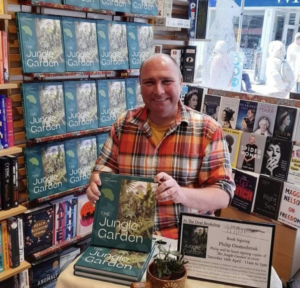Jungle Gardening in a Historic Garden.

Walmer Castle and Gardens lies on the East Kent coast, about 10 minutes north of Dover and is looked after by English Heritage. The gardens are approximately 8 acres, but the grounds, which include the beach, are about 22 acres. Within the gardens a woodland and meadow can be found, as well as an extensive kitchen garden, perennial borders with cloud hedges and a garden designed by Penelope Hobhouse for the Queen Mother’s 95th birthday.
The first time I visited Walmer Castle and Gardens I loved the space in the dry moat, up to 20 metres wide in places. About 6 metres below the level of the rest of the garden, it was created as a defence when the castle was built in 1539. It was never built to hold water, but once the enemy got in, it was very difficult for them to get out in a rush again, creating easy targets for the soldiers within the castle.
Throughout the centuries the moat had other functions too. It was filled with trees and shrubs at one point, was turned into a kitchen garden during the time the Duke of Wellington lived at Walmer Castle and had a tennis court in the early 20th Century. For the past 30 years or so it just had shrubs in borders along the castle walls and wasn’t high on the priority list.
When I applied for the job of Head Gardener I was very keen to hear about what would be possible in the moat. The Senior Gardens Advisor told me exactly what I was hoping for; that it just shouted out to be turned into a more tropical scene. As I love the style and have written a book called ‘The Jungle Garden’ I was looking forward to using different leaf shapes and sizes in the existing borders, making it look attractive from within the moat as well as from above. The reason we can use quite modern plantings in this historic part of the garden is that at Walmer Castle we haven’t got historic planting plans. With it (still) being the official residence of the Lord Warden of the Cinque Ports, the gardens have always seen many changes and we work more with a type of planting instead of particular plants. This means that within the moat we work with trees and shrubs in the planting but can work with more recent introductions. This means we have planted plants such as Tetrapanax, Pseudopanax and tree ferns, with underplanting of Boehmeria, Persicaria and Hakonechloa.
To have such freedom and being able to use modern introductions in a historic garden is quite unique. Within English Heritage we are curators of the gardens, so period gardens usually have to keep their planting period correct. We are after all looking after these gardens for future generations so people will be able to see a certain style of garden, or a garden by a certain designer in centuries to come. This is why we have gardens of all kinds of different periods within English Heritage. Although it can seem limiting to some, if you look at Victorian gardens and the number of plants that were introduced by the Victorians, you may discover otherwise. Some fine examples of period gardens within English Heritage are Brodsworth Hall and Gardens in South Yorkshire, Wrest Park in Bedfordshire and Osborne House on the Isle of Wight.
To see our progress in the jungle moat and visit Walmer Castle and Gardens you can book your tickets via the website. Although pre-booking isn’t necessary, it will always give you the best offer. Entrance is free for English Heritage members.
http://Walmer Castle and Gardens | English Heritage (english-heritage.org.uk)
You can also follow our progress via my personal Instagram account: @Mr. Plantaholic, or Twitter: @HG_Philip.
My book The Jungle Garden is available at many (online) bookshops, or more information can be found on

